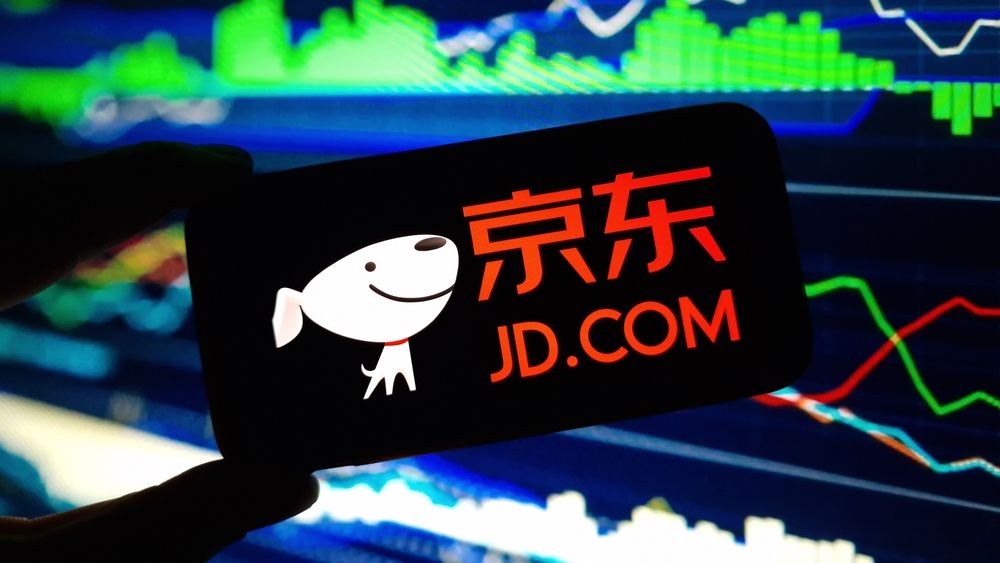Jingdong IPO: how to trade Jingdong shares

Learn about Jingdong and its potential IPO, what could impact its share price, and how to trade exposure to this stock via CFDs.
IPO stocks are often highly volatile, and early trading can involve rapid price swings and significant risk.
Create an account Open a demo account
When is the JingDong IPO date?
The JingDong IPO date has not been set, but the initial public offering is expected by the end of October, when it seeks to raise $500 million via a Hong Kong listing (source: Reuters).
JingDong is already listed on the Nasdaq Stock Market in the US and has had a secondary listing in Hong Kong since 2020. But as China’s second-largest e-commerce player, the company has been exploring spin-offs of its logistics, healthcare, property, and industrial units. JD Logistics and JD Health have already floated in Hong Kong.
Why now?
There are several motivations. JingDong needs capital to continue investing in its capital-heavy logistics and supply chain business. Splitting out these businesses allows each to access funding directly and gives investors clearer ways to value them. It also allows JingDong to highlight high-growth verticals such as healthcare and industrial supply, which can be obscured within the broader e-commerce business.
Equally, China’s regulators have encouraged ‘homecoming listings’ and restructuring of large internet platforms. By floating its subsidiaries, JingDong not only raises capital but also aligns with policy goals of transparency and value unlocking.
Bottom line: While JD.com itself has been public for a decade, the JingDong IPO now refers to the spin-off listings of its subsidiaries. A realistic JingDong IPO date is in 2025 or 2026, with a Hong Kong listing date likely.
What is JingDong?
JingDong, better known globally as JD.com, is one of China’s largest e-commerce and logistics companies. Founded in 1998 by Liu Qiangdong as a small Beijing electronics shop, it shifted online in 2004 and quickly grew into a direct competitor to Alibaba.
Unlike Alibaba’s asset-light model, JingDong built a vertically integrated system. It purchases and warehouses inventory, operates its own fulfilment centres, and employs delivery staff. This has made JingDong synonymous with reliability and fast shipping. While capital intensive, it differentiated JD as a platform that could guarantee authenticity, in a market long plagued by counterfeits.
Business operations
JingDong’s operations span multiple areas:
- E-commerce: the core business. JD sells electronics, apparel, food, and daily goods directly, and also runs a third-party marketplace for independent merchants.
- Logistics: JD Logistics is a leader in warehousing and delivery, offering same-day or next-day service to most of China.
- Healthcare: JD Health, already listed, is a leading online pharmacy and telemedicine platform.
- Finance: JD Digits provides consumer credit and payment solutions.
- Industrial technology: JD Industrials develops B2B procurement and supply chain systems.
- Property and infrastructure: JD Property manages logistics parks, data centres, and warehousing assets.
Global footprint
JingDong’s operations extend beyond China. It has invested in Southeast Asian e-commerce players, explored European expansion through logistics hubs, and developed partnerships in markets such as Thailand and Indonesia. Its global ambition is to build a cross-border supply chain network that rivals Amazon in scale.
Key milestones
1998 – Liu Qiangdong founds JingDong.
2004 – Launches online store.
2014 – IPO on Nasdaq, raising $1.8bn.
2020 – Secondary listing in Hong Kong.
2021 – JD Logistics IPO.
2020-2021 – JD Health IPO.
2025-2026 – Expected IPOs of JD Industrials and JD Property.
Strategic importance
JingDong plays a critical role in China’s economy. Its logistics infrastructure has become national in scale, providing not just e-commerce fulfilment but also B2B supply chain services. Its healthcare and financial subsidiaries are embedded in China’s digital economy. For investors, the JingDong IPO represents exposure not just to retail, but to logistics, cloud, and healthcare.
How does JingDong make money?
JingDong’s revenues are large and diverse.
| Revenue stream | Description |
|---|---|
| Direct sales and marketplace commissions | The majority of revenue comes from direct online retail. JD buys inventory and sells it directly, accounting for most of its $150bn+ annual revenues. Commissions from third-party merchants complement this, creating a mix of low-margin retail and higher-margin platform fees. |
| Logistics services | JD Logistics earns revenue from warehousing, shipping, and last-mile delivery. It serves both JD.com’s e-commerce and third-party clients. |
| Healthcare and fintech | JD Health provides online consultations, prescriptions, and pharmacy services. JD Digits provides credit and payments, monetising financial services for JD’s consumer base. |
| Industrial and property services | JD Industrials earns from procurement systems, cloud services, and supply chain technology. JD Property monetises logistics real estate and data centres. |
What might influence the JingDong stock price?
The JingDong stock price after any future IPOs of subsidiaries will depend on external conditions, business fundamentals, competition, regulation, and investor sentiment.
Macroeconomic and sector trends
China’s economic slowdown remains a challenge, with consumer spending weaker in 2023-2024. This weighs on retail revenues. However, logistics and supply chain technology benefit from structural demand. Rising digital penetration and continued growth of e-commerce offset cyclical weakness. Currency movements also affect profitability, as JD earns in RMB but has international expansion plans.
Company fundamentals
Investors will assess revenue growth, logistics margins, and profitability of spin-offs. JD has historically prioritised growth and logistics investment, which has squeezed free cash flow. If subsidiaries demonstrate standalone profitability, they could attract premium valuations. Clear reporting of margins, customer retention, and logistics efficiency will be crucial.
Competition and differentiation
JD faces intense competition from Alibaba, Pinduoduo, and Meituan. Pinduoduo’s low-cost model has rapidly captured market share. JD’s defence lies in logistics reliability and product authenticity. If it maintains these advantages, it can sustain a premium brand image. If rivals erode JD’s differentiation, growth could suffer.
Regulation and governance
Chinese tech companies face ongoing scrutiny, from antitrust measures to data-use restrictions. Any new rules could affect JingDong’s business lines, particularly in fintech and healthcare. Internationally, investor trust in Chinese corporate governance remains fragile. Strong disclosure and transparent reporting will be key.
Valuation scenarios
A bull case, with strong logistics growth and global expansion, could push valuations higher. A bear case, with continued weak consumer spending and regulatory pressure, could compress valuations. Early trading of the JingDong stock price in subsidiaries will reflect investor confidence in the group’s restructuring strategy.
Investor sentiment
IPO timing is critical. Global appetite for Chinese equities has been volatile. Strong anchor investor participation in Hong Kong IPOs will help. Sentiment toward Chinese internet stocks more broadly will drive multiples.
How to trade JingDong shares via CFDs
When the Jingdong listing date happens, traders will be able to speculate on its shares via contracts for difference (CFDs). CFDs allow you to capture price movements without owning the underlying shares, offering flexibility in volatile IPO markets.
How to get started
- Step 1: Choose a platformUse a broker like Capital.com to access IPO stocks and fintech names.
- Step 2: Open an accountComplete ID verification and the suitability assessment to begin trading.
- Step 3: Fund your accountDeposit capital securely by bank transfer, card, or e-wallet.
- Step 4: Track IPO detailsWatch the filing documents, price range, and anchor investor demand to gauge sentiment.
- Step 5: Place your tradeGo long if you expect JingDong to rally, or short if you anticipate it to fall, and consider applying stop-losses* to manage risk.
Note: the Jingdong IPO, like all IPOs, may be volatile, especially in the early days of trading. CFDs let you act on price swings in either direction, but always apply risk management. CFDs are traded on margin, and leverage higher than 1:1 magnifies potential losses and gains. Past performance is not a reliable indicator of future results.
Learn more about contracts for difference in our CFDs trading guide. *Standard stop-losses are not guaranteed. Guaranteed stop-losses incur a fee when activated.
Which e-commerce and tech stocks can I trade?
Until the JingDong launch date of new subsidiaries, traders can watch related stocks for sentiment:
- Alibaba (BABA) – JingDong’s main domestic rival.
- Meituan (3690.HK) – major Chinese services and delivery platform.
- Amazon (AMZN) – global e-commerce leader and logistics innovator.
- Sea Limited (SE) – Southeast Asian e-commerce and fintech company.
FAQs
What is the JingDong IPO?
The JingDong IPO refers to the spin-off IPOs of JingDong subsidiaries, such as JD Industrials and JD Property, rather than the parent’s original listing.
When will the JingDong IPO take place?
Analysts expect a 2025-2026 IPO window, though no official JingDong IPO date has been set.
Has JingDong set a listing date?
No final listing date has been announced, but Hong Kong is expected to be the venue.
What is JingDong worth?
Parent JD.com is currently valued around $50bn. Subsidiary IPOs could unlock an additional $10-15bn in shareholder value.
What does JingDong do?
JingDong operates e-commerce, logistics, healthcare, fintech, industrial supply chain, and property businesses.
Discover more upcoming IPOs
Stay informed on upcoming IPOs, market trends, and the newest trading opportunities

Verisure IPO
